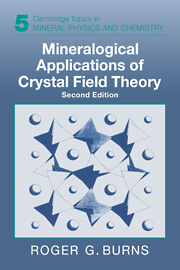Book contents
- Frontmatter
- Contents
- Preface to the first edition
- Preface to the second edition
- 1 Introduction
- 2 Outline of crystal field theory
- 3 Energy level diagrams and crystal field spectra of transition metal ions
- 4 Measurements of absorption spectra of minerals
- 5 Crystal field spectra of transition metal ions in minerals
- 6 Crystal chemistry of transition metal-bearing minerals
- 7 Thermodynamic properties influenced by crystal field energies
- 8 Trace element geochemistry: distribution of transition metals in the Earth's crust
- 9 Mantle geochemistry of the transition elements: optical spectra at elevated temperatures and pressures
- 10 Remote-sensing compositions of planetary surfaces: applications of reflectance spectra
- 11 Covalent bonding of the transition elements
- Appendices
- References
- Subject index
Preface to the first edition
Published online by Cambridge University Press: 23 November 2009
- Frontmatter
- Contents
- Preface to the first edition
- Preface to the second edition
- 1 Introduction
- 2 Outline of crystal field theory
- 3 Energy level diagrams and crystal field spectra of transition metal ions
- 4 Measurements of absorption spectra of minerals
- 5 Crystal field spectra of transition metal ions in minerals
- 6 Crystal chemistry of transition metal-bearing minerals
- 7 Thermodynamic properties influenced by crystal field energies
- 8 Trace element geochemistry: distribution of transition metals in the Earth's crust
- 9 Mantle geochemistry of the transition elements: optical spectra at elevated temperatures and pressures
- 10 Remote-sensing compositions of planetary surfaces: applications of reflectance spectra
- 11 Covalent bonding of the transition elements
- Appendices
- References
- Subject index
Summary
This book arose from a series of lectures given at the Universities of Cambridge and Oxford during the Spring of 1966. The lectures were based on material compiled by the author between 1961 and 1965 and submitted in a Ph.D. dissertation to the University of California at Berkeley. At the time crystal field theory had become well established in chemical literature as a successful model for interpreting certain aspects of transition metal chemistry.
For many years the geochemical distribution of transition elements had been difficult to rationalize by conventional principles based on ion size and bond type criteria. In 1959 Dr R. J. P. Williams, a chemist at Oxford conversant with the data from the Skaergaard intrusion, was able to present an explanation based on crystal field theory of the fractionation patterns of transition elements during crystallization of basaltic magma. This development led to the author's studying, under the supervision of Professor W. S. Fyfe, other mineralogical and geochemical data of the transition elements which might be successfully interpreted by crystal field theory.
In addition to suggesting applications of crystal field theory to geology, this book reviews the literature on absorption spectral measurements of silicate minerals and determinations of cation distributions in mineral structures. Many of these data have not been published previously. Spectral measurements on minerals have revealed many advantages of silicates as substrates for fundamental chemical studies. First, crystal structures of most rock-forming silicates are known with moderate to high degrees of precision. Secondly, minerals provide a range of coordination symmetries many of which are not readily available to the synthetic inorganic chemist.
- Type
- Chapter
- Information
- Mineralogical Applications of Crystal Field Theory , pp. xvii - xxPublisher: Cambridge University PressPrint publication year: 1993



